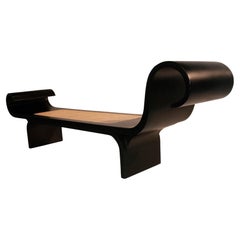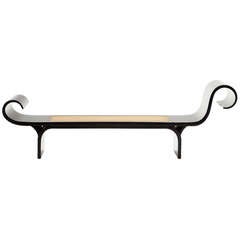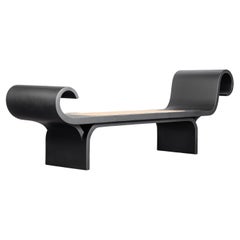Oscar Niemeyer Marquesa
Mid-20th Century Brazilian Mid-Century Modern Benches
Rattan, Wood
Recent Sales
21st Century and Contemporary Brazilian Modern Benches
Cane, Wood
Vintage 1970s Brazilian Mid-Century Modern Benches
Cane, Hardwood, Lacquer
Vintage 1970s Brazilian Mid-Century Modern Benches
Cane, Plywood
21st Century and Contemporary Brazilian Benches
Early 2000s Brazilian Post-Modern Benches
Cane, Wood
People Also Browsed
2010s American Table Lamps
Brass
2010s South African Minimalist Night Stands
Wood
Early 2000s Italian Mid-Century Modern Wall Lights and Sconces
Brass
Vintage 1950s German Mid-Century Modern Stools
Metal
2010s Egyptian Modern Coffee and Cocktail Tables
Oak
Late 20th Century Italian Mid-Century Modern Stools
Wood, Rope
Vintage 1970s Italian Mid-Century Modern Lounge Chairs
Aluminum
Late 20th Century German Industrial Musical Instruments
Metal, Aluminum
Vintage 1920s Danish Scandinavian Modern Bookcases
Mahogany
Vintage 1930s French Art Deco Daybeds
Wood
21st Century and Contemporary Italian Mid-Century Modern Wall Lights and...
Brass
Mid-20th Century French Mid-Century Modern Daybeds
Brass, Wrought Iron
2010s French Minimalist Chandeliers and Pendants
Alabaster, Brass
Vintage 1950s Brazilian Mid-Century Modern Lounge Chairs
Steel
Vintage 1970s Italian Modern Dining Room Chairs
Pine
Vintage 1980s Italian Post-Modern Wardrobes and Armoires
Glass, Walnut
Oscar Niemeyer for sale on 1stDibs
Oscar Niemeyer made modernist architecture sexy. In his signature designs, such as those for the planned capital city of Brasília, Niemeyer created a distinctively buoyant architectural vocabulary of sweeping curves, flowing lines and organic forms (attributes that also characterize his seductive furniture). As expressions of faith in the power of modern architecture and design to foster progress, Niemeyer’s buildings have a kind of heroic poetry.
Oscar Ribeiro de Almeida Niemeyer Soares Filho was born to an upper-middle-class family in Rio de Janeiro. (His father was a graphic designer.) While in graduate school, Niemeyer began working for Lúcio Costa, one of the few modernist architects working in Brazil in the 1930s. Niemeyer would be assigned to the design team for a new building in Rio for the Ministry of Education and Health. The famed Swiss-born French architect Le Corbusier was hired as a consultant on the project, and through him Niemeyer would absorb many lessons in bringing a sense of structural lightness to large buildings — though he would never embrace the geometric forms espoused by Le Corbusier and the members of the Bauhaus.
“I am not attracted to straight angles or to the straight line, hard and inflexible, created by man,” Niemeyer would write in his memoirs. “I am attracted to free-flowing sensual curves.”
Nowhere would Niemeyer demonstrate his love of curvature more expressively and elegantly than in his designs for the principal buildings for Brasília, a project begun in 1956. The dramatic Congressional Palace features two stark towers flanked by a domed structure and a bowl-shaped edifice, for the upper and lower legislative houses. He placed the Palácio da Alvorada (the presidential residence) on a small peninsula jutting into a lake, so that the sequence of parabolic columns on its facade casts a mirror image on the water. Niemeyer’s grandest achievement was the city’s cathedral, a stunning composition of 16 arched vertical supports with tinted-glass interstices.
Four years after Brasília was completed, in 1960, Brazil’s elected government was overthrown in a military coup. Niemeyer, a member of the Communist party, was harassed continually by the junta. He left the country and did not return until democracy was restored, in 1985.
While in exile, in the early 1970s, Niemeyer began collaborating on furniture designs with his daughter, Anna Maria Niemeyer. Their best known pieces are seating furniture — the Alta lounge chair and ottoman and the Rio rocking chaise, which have flowing bases made of sheets of lacquered wood or stainless steel, share the aesthetics of Niemeyer’s architecture.
The Alta’s deep, oversized seat pads nod — much like the chair designs of Niemeyer’s countryman Sergio Rodrigues — to the Brazilian penchant for long, languorous conversations. Examples of both designs are priced at about $20,000, depending on age, condition and materials. As you will see on these pages, Oscar Niemeyer’s furniture designs are sleek, sculptural, comfortable and elegant — as well as a compact emblem of the work of one of the great architects of our time.
Find vintage Oscar Niemeyer lounge chairs, tables and other furniture on 1stDibs.
On the Origins of Brazil
More often than not, vintage mid-century Brazilian furniture designs, with their gleaming wood, soft leathers and inviting shapes, share a sensuous, unique quality that distinguishes them from the more rectilinear output of American and Scandinavian makers of the same era.
Commencing in the 1940s and '50s, a group of architects and designers transformed the local cultural landscape in Brazil, merging the modernist vernacular popular in Europe and the United States with the South American country's traditional techniques and indigenous materials.
Key mid-century influencers on Brazilian furniture design include natives Oscar Niemeyer, Sergio Rodrigues and José Zanine Caldas as well as such European immigrants as Joaquim Tenreiro, Jean Gillon and Jorge Zalszupin. These creators frequently collaborated; for instance, Niemeyer, an internationally acclaimed architect, commissioned many of them to furnish his residential and institutional buildings.
The popularity of Brazilian modern furniture has made household names of these designers and other greats. Their particular brand of modernism is characterized by an émigré point of view (some were Lithuanian, German, Polish, Ukrainian, Portuguese, and Italian), a preference for highly figured indigenous Brazilian woods, a reverence for nature as an inspiration and an atelier or small-production mentality.
Hallmarks of Brazilian mid-century design include smooth, sculptural forms and the use of native woods like rosewood, jacaranda and pequi. The work of designers today exhibits many of the same qualities, though with a marked interest in exploring new materials (witness the Campana Brothers' stuffed-animal chairs) and an emphasis on looking inward rather than to other countries for inspiration.
Find a collection of vintage Brazilian furniture on 1stDibs that includes chairs, sofas, tables and more.
Finding the Right Benches for You
Don’t underestimate a good bench — antique and vintage benches are storage pieces, stylish accents and statement-making additional seating.
Today, benches are a great option to maximize seating in your house and outdoor space. The perfect option to create a warm, welcoming atmosphere in foyers and entryways, benches can also transform dining areas, making it possible to host a hungry family with limited space. Whether you’re sprucing up your entertaining with upholstered Empire-style benches or adding more options to a dining room that’s seen a farmhouse makeover, this humble furnishing has only become more versatile over the years. Designers have recognized the demand for a good bench, crafting the convenient seating alternative from a range of materials, including wood, iron and even concrete.
Mid-century modern benches from George Nakashima, Charlotte Perriand and the pared-down Platform bench by George Nelson for Herman Miller are classics of innovation, but maybe you’re looking for an unconventional design approach to your home's seating. Opt for something totally outside the box — an antique pine church-pew bench paired with a vintage wool throw and stationed under the mounted coatrack in your mudroom is a distinctive touch.
For your outdoor oasis, a wrought-iron patio bench is the obvious choice but not the only option. An enclosed back patio would do well to inherit a rattan bench with cushions, but it can be susceptible to weathering and should be covered or moved indoors when not in use.
Whatever your seating arrangement needs are, find vintage, new and antique benches for every space on 1stDibs.


